
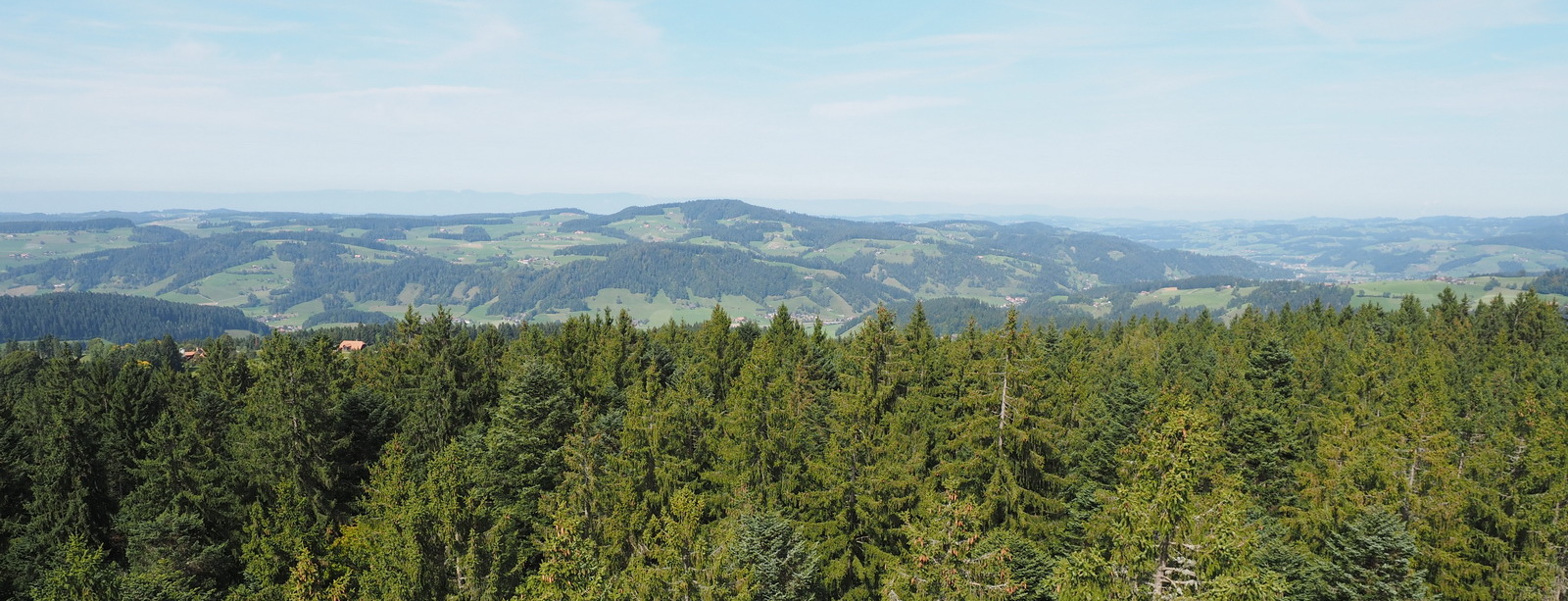


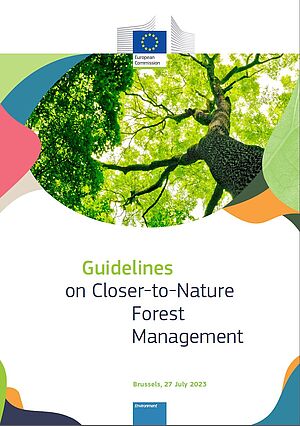
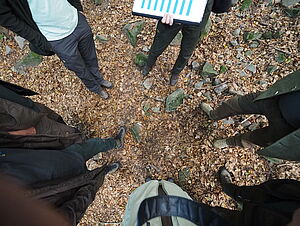
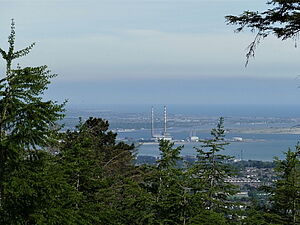
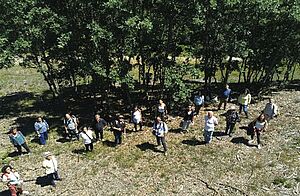
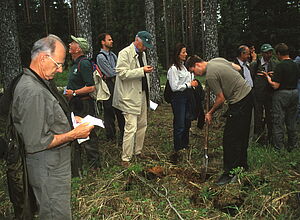
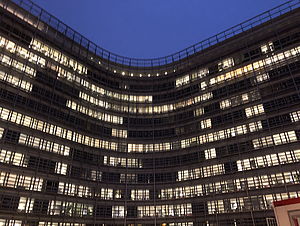
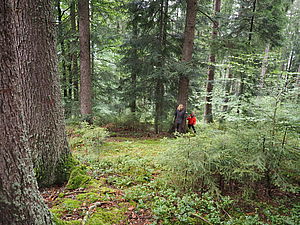
This report was written by Brice de Turckheim in 2002 and published in the newsletter "La Lettre de PRO SILVA FRANCE" - Décembre 2002. N°31, page 7-8, translated 2020
Report of the Board of Directors' forestry tours in Switzerland
The directors of PRO SILVA EUROPE met for their annual meeting in Couvet, Switzerland, at the invitation of the Swiss Working Group for Natural Forest Management (GFN-CH). They were accompanied by about 20 other members of the national associations. 17 European countries were represented.
After a round-table discussion summarising the PRO SILVA activities of the various countries, the following decisions were taken:
The forestry tours took participants first to the Couvet forest, then to the Bernese Emmental near Thun, to the Boudry mountain descending from the Jura ridge to Lake Neuchâtel, and finally to a small private forest in the Upper Jura near the Brevine, described as Swiss Siberia.
All the tours, remarkably well organized, were led by Léonard Farron, cantonal forest inspector of Neuchâtel, current president of the GFN-CH (= ANW Switzerland or PRO SILVA Switzerland).
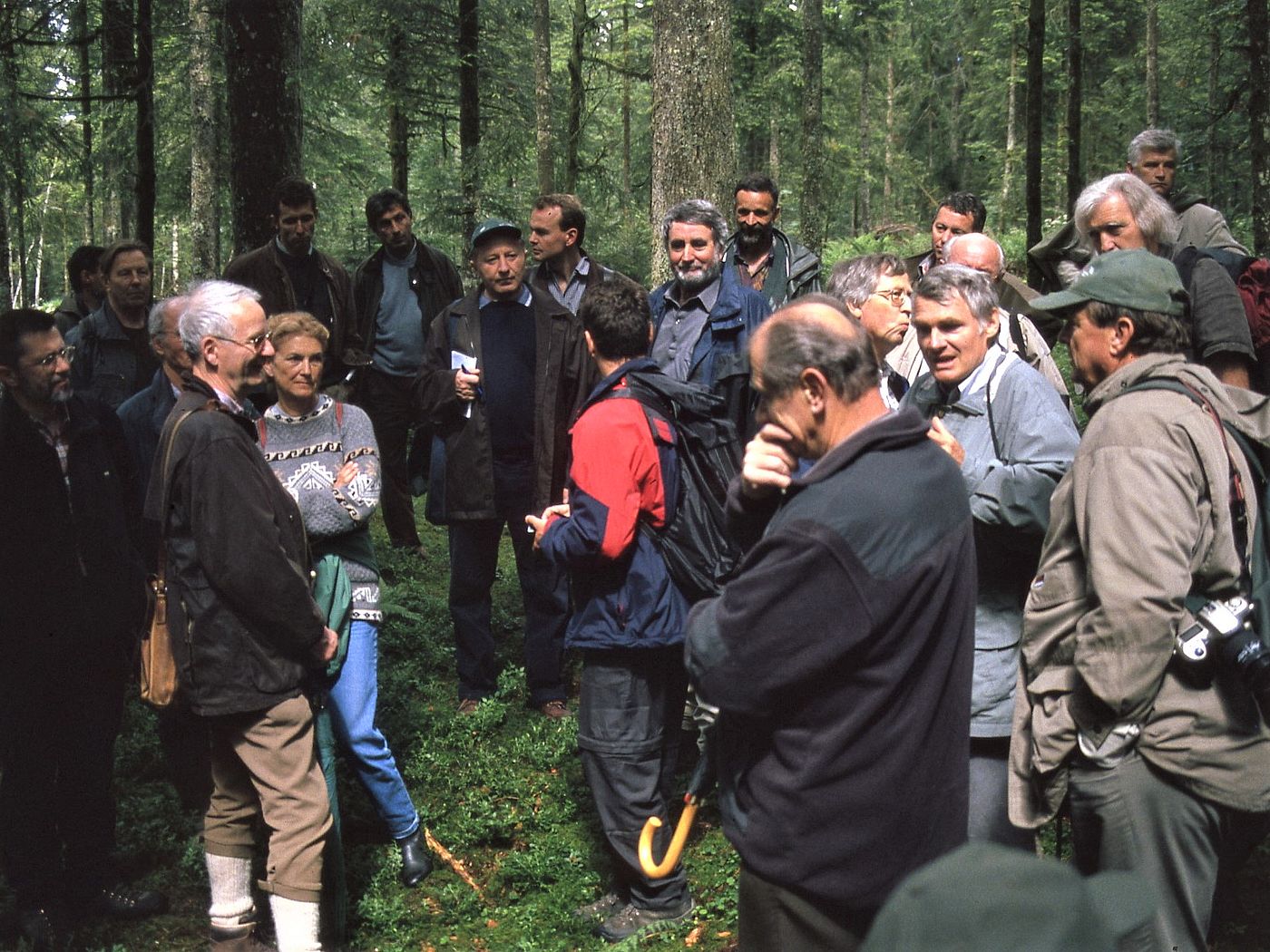
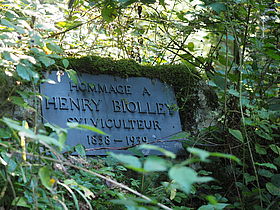
The communal forest of Couvet owes its great celebrity to the work of Henry Biolley and his successors. Around 1880, Biolley, arriving as a young engineer in the Val de travers, very quickly noticed the great disadvantages of regular high forest treatment, with regeneration by edge cutting, which were advocated by the higher forestry education of the time and the State forestry administration. These drawbacks were particularly evident in terms of stand stability and the serious sacrifices in exploitability that this method entailed. He compared this well-ordered treatment with the more or less anarchic selective cuttings traditionally practised by peasants, and laid down the principles of cultivated selective cuttings.
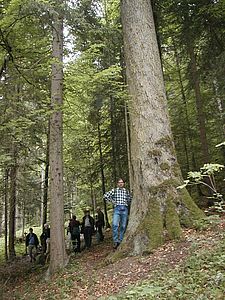
He enthusiastically took up Gurnaud's ideas, and developed, refined the Method of Control and codified some of its principles. The forest of Couvet has been inventoried every 7 to 9 years, since 1890, without any modification of the method or of the boundaries of the compartments (5-20 ha), which gives us a perfect synthetic view, valid for more than a century, of all the growth processes, the growing material, the cutting... Due to a lack of time, we could only visit the part of the forest situated on the North slope (l'Envers). The stands on this slope have between 400 and 450 sylves/ha (1 sylve = about 1 m3 management) with 50% or more of the volume of wood with a diameter greater than 52.5 cm.
Over the years, the overall volume has remained very close to constant, with an increase in the proportion of large wood, which is currently levelling off. The light entering the stands visited is remarkable. It is due, despite the large amount of standing material, to the size and height of the dominant trees. The arrival and good installation of hardwoods, notably Beech and Sycamore Maple, is very pleasing. However, the damage caused by the overdensity of deer and chamois is endangering the survival of the regeneration of the silver fir.
The "control method" (Gurnaud-Biolley) is based on a periodic enumeration of all standing trees (17,5cm + diameter) per compartment at a time interval of 8-12 years, depending on the economic situation. All the cut trees must also be registered per compartment and year, dead trees as well. Periodic Growth is obtained by comparison of 2 successive enumerations taking into account cut and dead trees. The allowable cut can be derived from the results of this comparison, taking into account the standing volume (plus considerations of the changes of the species composition and of the size classes).
The mountain selection forests ("forêts jardinées") near Thun are much richer. In contrast to Neuchâtel's beech-fir forest, the proportion of deciduous trees is very low, also as a result of centuries of overexploitation of beech. The average standing volume is around 520 m3/ha and sometimes exceeds 620 m3/ha. The recruits, unlike the groups seen at Couvet, are often individualized from a very young age. But the shade of the large trees allows very early pruning, so that without any artificial intervention, the wood produced is largely knotless. Silvicultural costs are practically absent in the property accounts.
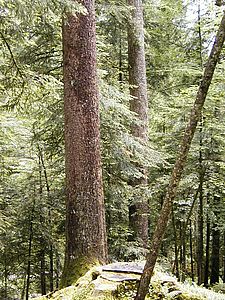
The Emmental region was badly affected by Hurricane Lothar on 26 December 1999. The volume of windfall in the forests visited amounted to about 100 m3/ha, i.e. 10 annual possibilities. A few gaps were caused by the wind over small areas. They were either reforested naturally or will be supplemented by a few plantations, notably of deciduous trees. This damage was studied by the Chair of Forest Management and Growth at the Swiss Federal Institute of Technology in Zurich and was the subject of an article published in the Swiss Forestry Journal (No. 11/01- 152nd year, Dvorak, Bachmann and Mandallaz).
On an area of 500 ha, the damage reaches 18 % of the number of stems and 24 % of the standing material. Acidic or wet sites, as well as situations on flat ground are the most affected. Balanced seeded forest is less damaged than stands under conversion, and the latter significantly less than regular stands. The damage is more severe on Spruce than on Fir, and on Fir more than on Beech.
Harvests less than 5 years old or more than 15 years old destabilize the stand more than interventions from 5 to 15 years ago. In addition, stands are more stable after average harvests of 70 to 150 m3/ha than after harvests below or above these figures. Damage rates are very high in poor stands at less than 200 m3/ha but rich growing stock over 600 m3/ha is by no means a cause of above average damage. In the case of damage above the 70% rate of growing stock, the presence of young stems generally allows natural recovery without intervention.
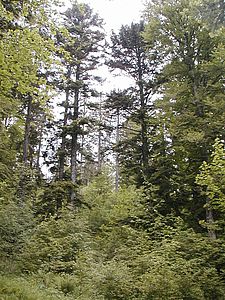
The tour of the Boudry mountain allowed the forest service to explain the silvicultural principles of the canton of Neuchâtel. The cantonal forestry law of 6 February 1996 states that "Nature-friendly silvicultural practice aims to ensure sustained stand production, to shape stands with diversified structure, to favour natural regeneration, to prohibit clearcutting, and to subject to authorization cuts whose effects are similar to clearcutting if they are necessary to regenerate light species or to transform stands that are unsuitable for the site.” These treatment principles lead to :
It is important to note that the "forest" is made up of as many different types of trees as possible, rather than imposing a single method of treatment. Hammering is carried out in the sense of free cutting... Harvesting is observed, it is not decreed".
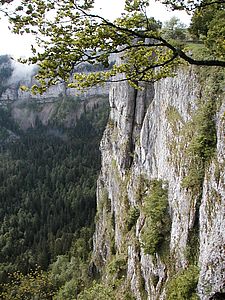
The descent on foot down a 1000 m difference in height made it possible to study all the methods of treatment, from the foot-to-foot gardening at altitude to the mosaic and bunch selective cuttings still relatively extensive in the stations at Frêne and Erables (progressive cuts leading to regular structures) and also passing through areas of former windfall in the process of reconstitution and natural structuring.
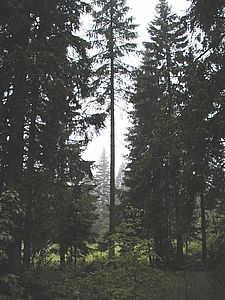
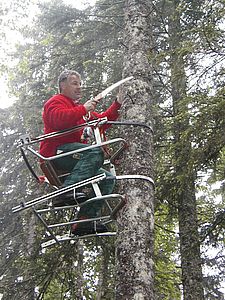
Finally, on the last day, and in pouring rain, the visit to the private forest of Les Cottards near La Brévine was a very instructive conclusion. With a wooded area of 35 ha, plus 18 ha of pastures, this forest has three types of stands: the former garden forests, the artificial reforestation being converted and the former wooded pastures. The altitude ranges from 1125 to 1185 m on the northern slopes of the Haut Jura.
The composition of the stands is as follows: Spruce: 64% by volume and 57% by number of stems, Fir: 30% and 30%, Hardwoods: 6% and 13%. Total volume: 433 sylves/ha for 313 stems. Average tree volume: 1.38 sylves. Structure: 15 % PB, 45 % BM and 40 % GB.
Objective: BP: 20%, WB: 30% and GB: 50%. Cutting at 9-year rotation. Reduce the volume to 400 sylves/ha. Artificial pruning at 9.5 m from elite trees, with a chair to climb the stem. All trees pruned by a local contractor are numbered and geographically located on the plot plan. In addition, the owners' representative, himself a co-owner, prunes trees, but does not number them. The pruning height, which varies according to the diameter of the stem concerned, is noted by spots of various colours following a code.
Pruning in Les Cottards: up to 15 m. height, depending on the size of the tree to be pruned. The aim of the pruning is to maximize the volume of A++quality Norway spruce, from less than 3% in year 2000 up to 60% in the future! - Since 2015, résonance logs (for manufacturing harps) have been sold in Les Cottards.
Management logo: To achieve the top reputation of the European forests!
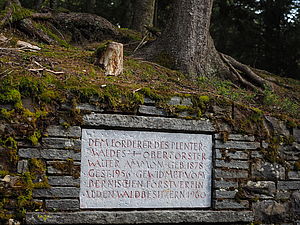
This tour in Switzerland was very instructive in terms of single tree selection forestry. It made it possible to compare Neuchâtel's designs on stations with high leaf pressure on limestone at medium altitude, with those at higher altitudes under harder conditions, but also with Bernese silviculture on dominant fir trees. The former work with standing volumes of around 400 m3/ha, the latter with around 600 m3/ha. However, all of them give priority to the production of large timber, which often accounts for more than 50% of the growing stock.
Discussions focused on ideal equipment, product quality, harvesting diameter, tree health, recruitment and education, light requirements, number of working hours and various costs. But reflections on stand typology were totally absent from the often passionate and high-level discussions.
Brice de Turckheim, 2002